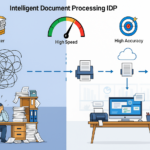Introduction:
The rapid evolution of technology has brought about a digital revolution that has touched virtually every aspect of our lives. From smartphones and IoT devices to cloud services and blockchain, the digital landscape is vast and ever-expanding. In this interconnected world, interoperability has emerged as a critical factor, ensuring that diverse technologies and systems can communicate effectively. In this blog post, we explore the future of interoperability and how it’s shaping the way businesses and individuals interact within the digital ecosystem.
The Current State of Interoperability:
In the current landscape, interoperability primarily addresses the technical and syntactic facets, striving to facilitate seamless communication and data sharing among systems. Despite notable advancements, the ever-evolving tech sphere presents persistent challenges. The need to adapt and innovate remains paramount as novel technologies continuously reshape the interoperability landscape, compelling us to find inventive solutions to bridge digital divides.
The Expanding Digital Ecosystem:
In this dynamic landscape, achieving interoperability becomes increasingly intricate as the digital ecosystem expands. Emerging technologies like artificial intelligence, blockchain, 5G, and IoT devices introduce new layers of diversity, creating a pressing need to harmonize these diverse components. This complexity underscores the critical importance of addressing interoperability challenges in order to fully harness the potential of the ever-evolving digital realm.
Challenges and Opportunities:
The challenges of interoperability are numerous. Technical standards must be updated, and semantic meaning must be shared effectively. Additionally, the legal and regulatory aspects of interoperability are becoming more complex, especially when it comes to data privacy and security.
However, these challenges also present opportunities. Businesses and organizations that can successfully navigate these challenges will have a competitive edge. They’ll be able to tap into the full potential of the digital ecosystem, offering more value to their customers and stakeholders.
The Future of Semantic Interoperability:
Semantic interoperability, which focuses on the meaning of exchanged data, will become increasingly vital. With the rise of AI and machine learning, the ability to understand and process data in a context-aware manner will be a game-changer. Standards organizations and industry leaders will play a crucial role in defining common ontologies to facilitate this.
This evolution toward semantic interoperability will enable systems to not just exchange data but to understand and act on it intelligently. For instance, in the healthcare industry, interoperable systems will be able to comprehend patient records in a way that allows for more accurate diagnosis and personalized treatment plans. In manufacturing, semantic interoperability will enhance supply chain efficiency by enabling real-time data analysis and optimization.
The Role of Blockchain:
Blockchain, often seen as a challenge in terms of interoperability due to its closed-circuit nature, also holds the potential to be part of the solution. Cross-chain interoperability protocols are being developed to enable different blockchains to communicate and share data. This is a significant step toward a more integrated digital ecosystem.
Imagine a future where blockchain technologies seamlessly connect, allowing for the secure and transparent transfer of assets across different platforms. Businesses will have more options to choose the blockchain that best suits their needs while still being able to interact with partners and customers on different blockchains.
Legal and Regulatory Frameworks:
Addressing legal and regulatory interoperability is a complex endeavor. It requires collaboration on a global scale to create frameworks that protect data privacy and security while allowing data to flow seamlessly. Initiatives like the GDPR in Europe and similar efforts worldwide show progress in this area.
In the future, we can expect further international cooperation to establish legal standards that facilitate interoperability. This will be crucial in an era where data protection, digital identity, and cybersecurity are paramount. Businesses that operate on a global scale will need to navigate a patchwork of laws and regulations, making the harmonization of legal interoperability even more critical.
Conclusion – The Road Ahead:
The future of interoperability is bright but challenging. As the digital ecosystem continues to expand, there is a growing need for seamless integration across technologies and systems. While challenges persist, they provide opportunities for innovation and progress.
In this journey, SDEX is committed to being at the forefront of developing and implementing interoperability solutions. As technology evolves, so do our capabilities to ensure that your systems can communicate effectively, securely, and with semantic clarity. Join us in shaping the future of the digital ecosystem, where interoperability is the key to unlocking endless possibilities.
As we navigate this evolving landscape, one thing is clear: the future belongs to those who embrace interoperability as a strategic advantage. It’s not just about connecting systems; it’s about harnessing the full potential of the digital ecosystem to drive innovation and deliver greater value to businesses and individuals alike. With SDEX, you have a partner dedicated to making this future a reality.






